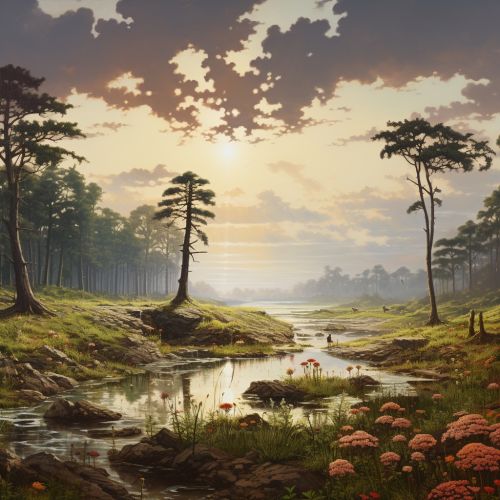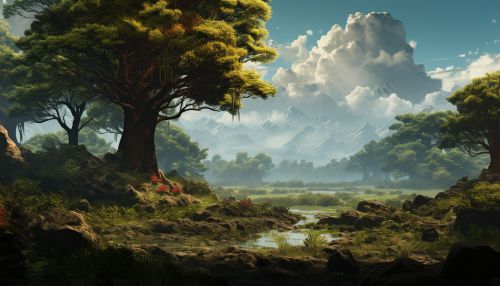Climate change and ecosystems
Introduction
Climate change is a long-term alteration in the statistical distribution of weather patterns over periods ranging from decades to millions of years. It may be a change in average weather conditions or a change in the distribution of weather events with respect to an average, for example, greater or fewer extreme weather events. Climate change is caused by factors such as biotic processes, variations in solar radiation received by Earth, plate tectonics, and volcanic eruptions. Certain human activities have been identified as primary causes of ongoing climate change, often referred to as global warming.
Ecosystems are communities of living organisms in conjunction with the nonliving components of their environment, interacting as a system. These biotic and abiotic components are linked together through nutrient cycles and energy flows. Ecosystems are controlled both by external and internal factors. External factors such as climate, the parent material which forms the soil, topography and time each affect ecosystems. While the internal factors include disturbance, succession and the types of species present.


Climate Change and Ecosystems
Climate change has significant impacts on ecosystems. The effects of climate change on an ecosystem can be profound, leading to shifts in the biotic and abiotic components of the ecosystem. These changes can affect the functionality of the ecosystem and its ability to provide services that are vital to both the natural world and human societies.
Effects on Biotic Components
Climate change affects the biotic components of ecosystems in several ways. Changes in temperature can affect the metabolic rates of organisms, influencing their growth, reproduction, and survival. For instance, warmer temperatures could mean more energy is available for growth and reproduction, but if temperatures become too high, they could exceed the tolerance levels of organisms, leading to declines in populations and even extinctions.
Changes in precipitation patterns can also affect ecosystems. More frequent and intense rainfall can lead to increased erosion and runoff, which can remove nutrients from the soil. On the other hand, reduced rainfall and increased evaporation can lead to drought conditions, affecting plant growth and survival.
Climate change can also lead to shifts in the distribution of species. As temperatures warm, species may move towards the poles or to higher elevations where conditions are more suitable. This can lead to changes in community composition and interactions among species. For example, the arrival of new species can lead to increased competition for resources, changes in predation rates, or the introduction of new diseases.
Effects on Abiotic Components
Climate change also affects the abiotic components of ecosystems. Changes in temperature and precipitation patterns can affect soil processes, hydrology, and atmospheric chemistry. For instance, warmer temperatures can increase the rate of soil decomposition, leading to increased release of carbon dioxide into the atmosphere. Changes in precipitation can affect the availability of water in the ecosystem, influencing plant growth and the distribution of aquatic species.
Increased levels of carbon dioxide in the atmosphere can also lead to ocean acidification, which can have profound effects on marine ecosystems, particularly organisms that form shells or skeletons made of calcium carbonate, such as corals and shellfish.
Responses of Ecosystems to Climate Change
Ecosystems respond to climate change in various ways, with changes in species distributions, community structure, and ecosystem processes. These responses can have significant impacts on ecosystem services, such as food production, water purification, and carbon sequestration.
Changes in Species Distributions
One of the most noticeable responses of ecosystems to climate change is shifts in species distributions. As mentioned earlier, as temperatures increase, species may move towards the poles or to higher elevations. However, not all species are able to move quickly enough to keep up with the pace of climate change, leading to local extinctions.


Changes in Community Structure
Climate change can also lead to changes in community structure. Changes in temperature and precipitation can favor certain species over others, leading to shifts in community composition. This can lead to changes in ecosystem processes, such as nutrient cycling and energy flow. For example, in many Arctic ecosystems, warming temperatures are leading to the expansion of shrubs and trees into areas that were previously dominated by grasses and mosses. This can affect the amount of snow that is able to accumulate, which can influence the insulation of the ground and the timing of snowmelt in the spring.
Changes in Ecosystem Processes
Climate change can also affect ecosystem processes. Changes in temperature and precipitation can affect the rates of primary production and decomposition in an ecosystem, influencing the cycling of nutrients and energy. For example, increased temperatures can increase the rate of decomposition, releasing more carbon dioxide into the atmosphere. However, changes in precipitation can influence the availability of water, which can affect plant growth and the amount of carbon that is sequestered in the ecosystem.
Impacts on Ecosystem Services
Ecosystems provide a range of services that are vital to human societies. These include provisioning services such as food and water; regulating services such as the regulation of climate and disease; supporting services such as nutrient cycling and soil formation; and cultural services such as recreational, aesthetic, and spiritual benefits. Climate change can affect the ability of ecosystems to provide these services, which can have significant impacts on human societies.
Impacts on Provisioning Services
Climate change can affect the provision of food and water. Changes in temperature and precipitation can affect crop yields, leading to decreases in food production. Changes in precipitation can also affect the availability of water, leading to water shortages. This can have significant impacts on human societies, particularly in regions that are already experiencing water stress.
Impacts on Regulating Services
Climate change can also affect the regulation of climate and disease. Ecosystems play a key role in regulating the climate by sequestering carbon dioxide from the atmosphere. However, changes in ecosystem processes such as decomposition can lead to the release of stored carbon, contributing to further climate change. Changes in temperature and precipitation can also affect the distribution of disease vectors, leading to the spread of diseases.
Impacts on Supporting Services
Climate change can affect supporting services such as nutrient cycling and soil formation. Changes in temperature and precipitation can affect the rates of these processes, which can influence the productivity of ecosystems. This can have impacts on other ecosystem services, such as food production.
Impacts on Cultural Services
Finally, climate change can affect cultural services. Changes in ecosystems can affect the aesthetic and recreational values of these systems. For example, changes in species distributions can affect wildlife viewing opportunities. Changes in ecosystems can also have spiritual impacts, particularly for indigenous communities that have strong cultural ties to the land.
Conclusion
Climate change has significant impacts on ecosystems and the services they provide. Understanding these impacts is crucial for developing strategies to adapt to climate change and mitigate its effects. While there are still many uncertainties, it is clear that the impacts of climate change on ecosystems are far-reaching and complex, affecting both the natural world and human societies.
